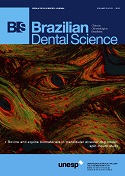Bovine and equine biomaterials in mandibular alveolar dog model: Split-mouth study
DOI:
https://doi.org/10.14295/bds.2016.v19i3.1291Abstract
A predictable rehabilitation of severely atrophied alveolar ridge defects still remains a matter of concern in implant dentistry. Objective: The aim of this study was to compare histologically biomaterials of bovine (Genox®) and equine (Bio-Gen®) origin associated or not to platelet-rich plasma (PRP), analyzing bone maturity, amount of mature (type I) and immature (type III) collagen present at sixty and ninety days in post-extraction alveolus. Materials and Methods: Four Beagle dogs were used from which the six mandibular premolars were extracted. The alveolus contained respectively: right side, Bio-Gen ® (group B), preserved the clot (group C), Genox ® (group G); left side, Bio-Gen ® + PRP group (BP), Clot + PRP (group CP) and Genox ® + PRP (group GP). After sixty and ninety days, two dogs were sacrificed at each date and the pieces were histologically processed and stained with picrosirius red, a specific stain for analysis of different types of collagen. Results: Comparisons of the averages of mature collagen at 60 days indicated significant differences between Group G when compared to Groups C and B. The biomaterial of bovine origin demonstrated higher amounts of mature collagen in 90 days while the biomaterial of equine origin had a higher average of immature collagen in 90 days. Conclusion: Groups associated to PRP were effective in the production of mature and immature collagen. Genox® associated with PRP demonstrated a more advanced stage of bone regeneration presenting as an alternative to fill post-extraction alveolus.
Downloads
Downloads
Published
How to Cite
Issue
Section
License
Brazilian Dental Science uses the Creative Commons (CC-BY 4.0) license, thus preserving the integrity of articles in an open access environment. The journal allows the author to retain publishing rights without restrictions.
=================




























